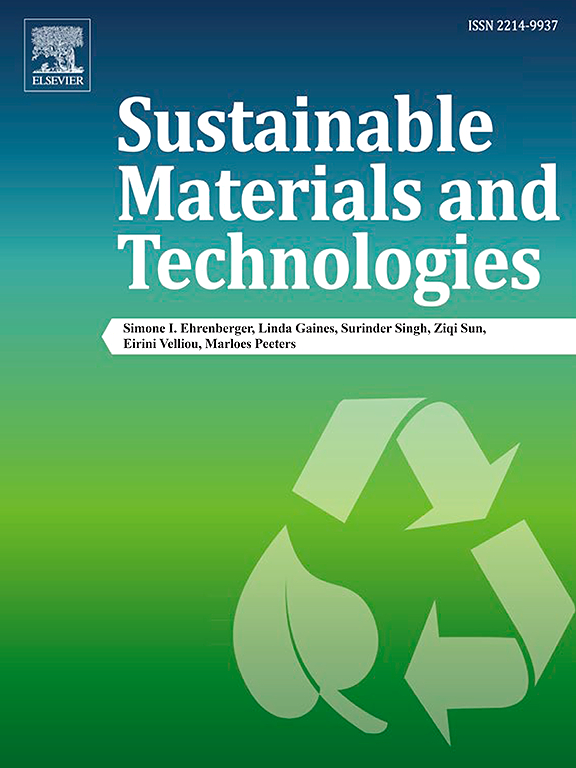叶绿体功能化ZnCo2O4电极在光电化学水分解中的自旋-电荷转换
IF 9.2
2区 工程技术
Q1 ENERGY & FUELS
引用次数: 0
摘要
为了开发出适合于光电化学(PEC)水分解和氢生成的光催化剂,目前的策略包括表面改性、异相掺杂或通过集成多种纳米材料形成异质结。另一方面,自旋极化已经成为一种有吸引力的技术,可以绕过这些复杂的过程。自旋极化通过利用电子的自旋自由度,有助于增强电荷输运和降低复合速率。ZnCo2O4 (ZCO)中Co3+和Co2+独特的电子构型为Co的自旋极化提供了基础,因为Co的3d轨道分裂为eg和t2g能级,从而表现出不同的自旋态。在激光照射和施加偏置电压等外部扰动下,这些自旋极化电子可以促进有效的电荷分离。因此,这项研究旨在首次对p型ZCO半导体作为光电催化剂进行分析。利用405 nm和808 nm激光器分析了自旋对电荷对光电流密度的影响。我们观察到,在外加偏置电位和模拟太阳光照下,光电流密度随ZCO的孔隙率和煅烧温度的升高而增加。本研究进一步比较了导电衬底(如碳纸)与氧化铟锡基电极对ZCO的PEC活性的影响。导电衬底,如碳纸,大大提高了光电流密度、稳定性和产氢性能。值得注意的是,在诱导极化的自旋下态,计算得到的产氢速率为11.58 mmol s−1 m−2。光电极上的叶绿体包覆改善了ZCO对可见光吸收差的问题,使其产氢速率提高到46.31 mmol s−1 m2。本文章由计算机程序翻译,如有差异,请以英文原文为准。
Spin-to-charge conversion of chloroplast-functionalized ZnCo2O4 electrode in photoelectrochemical water splitting
In the pursuit of developing suitable photocatalyst for application in photoelectrochemical (PEC) water splitting and hydrogen generation, the current strategies involve surface modification, heterogenous doping or heterojunction formation by integrating multiple nanomaterials. Spin polarization, on the other hand, has emerged as an attractive technique to bypass these complex processes. Spin polarization assists in enhancing charge transport and reduced recombination rate in PEC systems by leveraging the spin degree of freedom of electrons. The unique electronic configuration of Co3+ and Co2+ in ZnCo2O4 (ZCO) provides a foundation for spin polarization due to the splitting of Co 3d orbitals into eg and t2g energy levels, thereby exhibiting distinct spin states. Upon external perturbations such as laser irradiation and an applied bias voltage, these spin polarized electrons can facilitate efficient charge separation. This study, thus, aims at providing the first of its kind analysis of p-type ZCO semiconductors as a photoelectrocatalyst. The spin-to-charge effects on photocurrent density were analyzed using 405 and 808 nm lasers. We observe that under an applied bias potential and simulated solar light exposure, the photocurrent density increases proportional to the porosity and rising calcination temperature of ZCO. This study further compares the influence of conducting substrates, such as carbon paper, with indium tin oxide-based electrodes on the PEC activity of ZCO. Conducting substrates, such as carbon paper, substantially enhance photocurrent density, stability, and hydrogen generation performance. Notably, the calculated hydrogen generation rate of 11.58 mmol s−1 m−2 was maximized in the spin-down states of induced polarization. The poor visible light absorption of ZCO was improved by chloroplast coating on the photoelectrode, consequently elevating the hydrogen generation rate to 46.31 mmol s−1 m2.
求助全文
通过发布文献求助,成功后即可免费获取论文全文。
去求助
来源期刊

Sustainable Materials and Technologies
Energy-Renewable Energy, Sustainability and the Environment
CiteScore
13.40
自引率
4.20%
发文量
158
审稿时长
45 days
期刊介绍:
Sustainable Materials and Technologies (SM&T), an international, cross-disciplinary, fully open access journal published by Elsevier, focuses on original full-length research articles and reviews. It covers applied or fundamental science of nano-, micro-, meso-, and macro-scale aspects of materials and technologies for sustainable development. SM&T gives special attention to contributions that bridge the knowledge gap between materials and system designs.
 求助内容:
求助内容: 应助结果提醒方式:
应助结果提醒方式:


